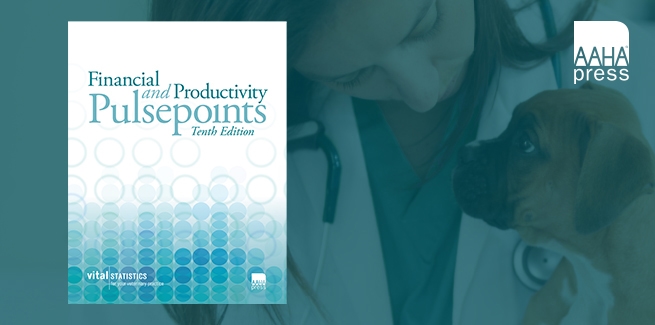Financial and Productivity Pulsepoints: A view from the benchmarking trenches

Benchmarking is a critical part of practice management. And if you’re not comparing your practice’s financial performance to similar practices, you’re curbing your profitability and limiting your hospital’s potential.
Financial and Productivity Pulsepoints, Tenth Edition, can help you unleash both.
A compilation of real-life data on revenue, expenses, and productivity from practices across the country, the all-new tenth edition of this must-have resource from AAHA Press contains the data, analysis, and context you need to measure your success against the standards of the profession, identify gaps, and develop action plans for improvement.
The benchmarks in Financial and Productivity Pulsepoints will help you understand how your practice stacks up.
But how do you use benchmarks?
NEWStat asked Judy Rose Lanier, CVA, CVPM. Before she took on the role of regional field manager on AAHA’s Member Experience team, Lanier spent two decades in the field as a certified veterinary assistant and certified veterinary practice manager. She regularly used Financial and Productivity Pulsepoints while she was a practice manager as well as when she was an AAHA practice consultant.
Lanier says that often, a practice manager or a new owner at an AAHA-accredited practice would ask her how they could find out how their practice compared to other hospitals. “I’d recommend Pulsepoints,” she says.
Then she’d haul out her own well-thumbed copy and show them how to use it. “And they’d say, ‘Oh, well, that seems super simple. I just plug in my numbers, and it’ll show me what’s going on and where I should be.’”
When she was a practice manager, Lanier found several of the revenue tables to be useful enough to consult them throughout the year: annual transactions per active client and new clients per full-time-equivalent veterinarian in particular. “And the average transaction charge,” Lanier adds. “That’s definitely something you want to reference quite a bit to make sure you’re on track.”
Lanier says there’s no particular trick to using Pulsepoints: “Before each table, it gives you an explanation of what you’re looking for and how to analyze what your numbers are. This is a tool even a pretty new practice manager could use—it’s very user friendly.”
When NEWStat asked for an example, Lanier chose annual transactions per active client.
“I would use this table to see if we were within the benchmarks of other AAHA-accredited practices based on the number of full-time veterinarians we had,” Lanier explains. “It’s a really great tool to use if you have a brand-new veterinarian come onboard and you want to see how they’re doing once they’re done training and working on their own. You can see how they compare to your other full-time veterinarians and find out if they need some coaching along the way.”
She says most practice management software will give you the figures you need, which makes it even easier. Then you simply input and compare.
Patterns emerge quickly: “I’ll see that [one veterinarian’s] annual exams are generating much less revenue than another doctor’s.” So do answers: “Then I’ll realize that, hey, they’re not charging for something,” says Lanier. In one memorable case, it was anal gland expressions. “The new guy was performing them, but not charging for them. Pulsepoints helps you catch things like that.”
You can plug those figures into the tables and see where you are. “Because that’s a question you’re always thinking about in practice: Am I charging too much, or am I charging too little? It’s a great way to see where everybody else is.”
“And the book has great tips. This is where you can find out how to get new clients and turn them into active clients, or how to offer different ancillary services, like boarding and grooming,” Lanier notes. “It’s not just, ‘Hey, plug in those numbers’—it actually gives you ideas about how to improve those numbers.”
Get your copy here and start improving your numbers today.



